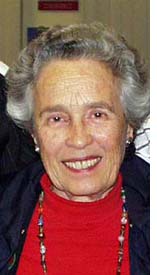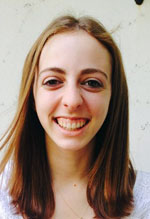By Eileen Wingard

SAN DIEGO — A newspaper clipping on my sister Zina’s table caught my eye during my recent visit back east. It was about a Tufts Professor who was committed to making society more scientifically literate. He not only taught, but had a laboratory where he did stem cell research. His name was Jonathan Garlick.
“Maybe Sara heard of him,” I said, thinking I will ask my granddaughter when I go to see her at Tufts that weekend.
Zina responded,“I cut out the article because his mother, Anita Garlick, is my upstairs neighbor.”
Several days later, I was on the T, on my way to Tufts. Two stops after Harvard Square, I got off and was met by my granddaughter, Sara. Over sandwiches at a nearby student hang-out, I asked if she had ever heard of Professor Garlick.
Her eyes widened and, with a big smile, she replied, “I have a class with him, Science and the Human Experience, and he is my favorite professor! In fact, I am having lunch with him next Monday.” Sara explained that he had invited his entire class to visit his stem cell laboratory and have dinner together. Because she needed to study for a final the next morning, she could not go. Professor Garlick, not wanting Sara to miss out, set up a special time for her to go to the lab and have lunch together afterwards.
Sara told me about some of the topics they discussed in class, scientific subjects which impacted the world and had human and environmental relevance. One of the assignments was to write op-eds on issues each student felt strongly about.
The following Monday, before I was to leave for the airport for my flight back to San Diego, Zina invited Jonathan’s mother, Anita Garlick, in for us to meet. Anita could only stay a short time because she had a book club meeting and a hair appointment that day. Despite the walker she used for assistance, this nonogenarian was a picture of vitality. She told me about all her three sons. Jonathan is the middle one. All are highly accomplished. They studied at the Hebrew University in Jerusalem, but returned to the states to be closer to her when her husband died. She has 10 grandchildren and, given their last name, calls them her “cloves.”
After she left, she phoned her son, Jonathan and teased, “I know whom you are having lunch with today, I just met her grandmother.” Later, she called us back to report that Jonathan said he enjoyed having Sara in his class. She was a bright and serious student.
When I read Sara’s op-ed, I realized what a wonderful class it must have been, studying Science and the Human Experience with Dr. Jonathan Garlick at Tufts University. The article is reprinted below.
**
The Choice about Choice
By Sara Schiff

The personal medical choices we make, such as deciding to obtain vaccinations, get abortions, and donate our embryos, are indeed our own personal choices. However, when our personal choices affect the safety or well-being of others, the freedom to choose becomes a societal matter rather than a personal choice. Our personal choices turn public the moment they begin to directly impact more than just ourselves.
This battle over the right of “choice” is well illustrated in the debate regarding childhood vaccinations against deadly diseases, especially in light of the recent measles outbreak at Disneyland. State Epidemiologist and Deputy Director of the Center for Infectious Diseases in the California Department of Public Health, Dr. Gil Chavez, stated, “Measles is extremely contagious and can be very serious. The best way to protect yourself and your family against measles is with the Measles Mumps and Rubella (MMR) vaccination, which is 97 percent effective after two doses.”
If parents had simply vaccinated their children as the pediatric medical community recommended, this outbreak would not have occurred. While it is understandable how other factors, such as religious values, play into a parent’s choice to vaccinate their children, the health of large populations of people must be the priority. By allowing one child to be unvaccinated, we put every vaccinated child at a greater risk of becoming sick, and thus we should not allow one person’s choice to invalidate the choices of many others. Therefore, the government should mandate vaccinations to protect the general population and honor the choice parents make to safeguard their children.
The topic of abortion is also centered around choice, but in a very different way than vaccinations. When a woman decides to get an abortion, the people affected are the mother and father of the unborn embryo(s) inside the woman’s body. Thus, the only people who should be able to make the personal choice of whether or not to have an abortion are that woman and that man. In contrast to vaccinations, the choice of a person to obtain an abortion will not have any negative impacts on the well-being of others. Religious factors are once again at play in this debate; however, even if a person’s religion does not support abortion, it remains entirely that person’s choice whether or not to obtain one.
In terms of governmental policy on abortions, there is a large gap in who makes decisions on the legality of abortions and who is directly impacted by the medical procedure. In our country today, those who are most affected by abortions are young black women. In fact, according to the Centers for Disease Control and Prevention, women aged 20-24 accounted for 32.9% of all abortions in 2011 and non-Hispanic black women accounted for 36.2% of all abortions in the same year. This contrasts greatly with the representation of black women in Congress. In fact, according to the Congressional Research Service, in the 113th Congress there were only 16 (3.7%) African American women serving in the House of Representatives and none in the Senate. Yet, the House of Representatives and the Senate are where laws determining the legality of abortion are either approved or disapproved. This is clearly backwards.
Lastly, there is the topic of whether or not women should be able to choose to donate their embryos for embryonic stem cell research. This circumstance parallels the abortion situation in that the fate of those embryos primarily affects the woman and man who created the embryo; however, embryonic stem cells also have the potential to greatly impact someone else. Compared to the case of no vaccinations though, this would result in a positive impact on others.
By donating embryonic stem cells, the donors further research that could one day change the life of a person suffering from a deadly degenerative disease such as Alzheimer’s or ALS. It is only right that people should be able to decide for themselves whether or not they want to help others in need. In other words, by donating their embryos, these people could be providing sick people a choice that they didn’t have before: the choice to live.
While it may seem difficult to balance a person’s right to make a choice on every issue, it is imperative that we do so as a country. If we do not, we will be supporting a society where an individual’s right to make a medical choice could be taken away unjustly. As long as our choices do not compromise the safety and well-being of others, individual freedom of choice should be honored. In sum, we must carefully choose which choices are ours.
Bibliography
Gore, Anita. “Recommendation: Protect Against Measles before International Travel .” Recommendation: Protect Against Measles before International Travel. April 17, 2015. Accessed April 22, 2015. http://www.cdph.ca.gov/Pages/NR15-019.aspx
Manning, Jennifer. “Membership of the 113th Congress: A Profile.” Congressional Research Service. November 24, 2014. Accessed April 22, 2015.
https://www.senate.gov/CRSReports/crs-publish.cfm?pid=%260BL%2BR%5CC%3F%0A
Pazol, Karen, Andreea Creanga, Kim Burley, and Denise Jamieson. “Abortion Surveillance — United States, 2011.” Centers for Disease Control and Prevention. November 28, 2014. Accessed April 22, 2015.
http://www.cdc.gov/mmwr/preview/mmwrhtml/ss6311a1.htm?s_cid=ss6311a1_w